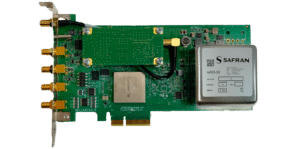
Safeguarding Data Concurrency with the ART Card
Introduction
In the ever-expanding realm of distributed data systems, where large volumes of information are processed and shared across multiple devices and locations, ensuring data concurrency becomes a critical challenge. The ability to maintain consistent and synchronized data across distributed systems is essential for reliable and efficient operations. This is where the ART (Atomic Real-Time) card, developed by Safran, emerges as a game-changer. By leveraging precise time synchronization and advanced synchronization mechanisms, the ART card offers a powerful solution to safeguarding data concurrency in distributed data systems.
The Significance of Time in Distributed Data Systems
Time is a fundamental aspect of distributed data systems. Inaccurate timekeeping or inconsistencies in time synchronization can lead to data discrepancies, integrity issues, and even system failures. Consider a scenario where multiple devices interact with a distributed database. Accurate timekeeping enables these devices to organize and process data in a consistent and coordinated manner. It allows for the identification and resolution of conflicts and ensures that data updates occur in the correct sequence. Therefore, a reliable and precise time synchronization mechanism is crucial to maintain data integrity and concurrency.
The ART Card: An Introduction

The ART card, developed by Safran, presents an innovative solution for achieving time synchronization and data concurrency in distributed data systems. Built upon atomic clock technology, the ART card offers unparalleled accuracy and stability in timekeeping. By employing high-precision, GPS disciplined oscillators and advanced synchronization algorithms, it enables devices across a network to maintain consistent time references, ensuring synchronized operations and data integrity.
Benefits of the ART Card for Data Concurrency
1. Precise Time Synchronization
The ART card ensures that all devices within a distributed system share the same accurate time reference. This synchronization allows for coordinated actions, eliminating conflicts and ensuring proper sequencing of data updates. By avoiding data collisions and inconsistencies, the ART card promotes data concurrency, enabling smooth and reliable operations.
2. Atomic Clock Accuracy
Leveraging atomic clock technology, the ART card provides an exceptionally precise timekeeping mechanism. This high level of accuracy is essential for applications that demand real-time data processing, such as financial transactions or industrial control systems. With the ART card, distributed data systems can achieve microsecond-level synchronization, significantly enhancing data concurrency and system reliability.
3. Scalability and Flexibility
The ART card is designed to scale effortlessly in distributed data systems. It can synchronize hundreds or even thousands of devices, making it suitable for a wide range of applications. The card’s flexibility allows it to be integrated into existing infrastructure, minimizing deployment complexities and enabling organizations to enhance data concurrency without significant system modifications.
Conclusion
In the realm of distributed data systems, maintaining data concurrency is paramount for achieving reliable and efficient operations. The ART card by Safran emerges as a critical enabler in this domain, offering precise time synchronization and advanced synchronization mechanisms. By ensuring consistent time references and synchronized operations across distributed devices, the ART card plays a vital role in preserving data integrity and concurrency. With its atomic clock accuracy, scalability, and flexibility, the ART card is poised to revolutionize distributed data systems, empowering organizations to harness the full potential of their data in an increasingly interconnected world.

 Related Resources
Related Resources
 Download
Download
Download the Atomic Reference Time Card capabilities specifications summary

